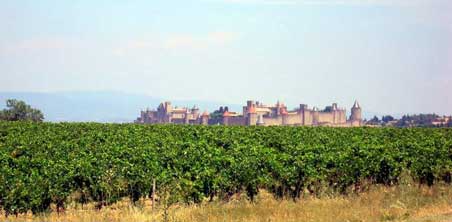
Graham Nutter of Ch St Jacques d’Albas in the Minervois sends this report on the 2007 harvest……

A warm/dry winter, a warm/damp spring (great for weeds) and a hot/cold but very dry summer! Top that with mildew and oidium in July, leading to sharp reductions in crop yield in some Languedoc areas. Who would want to be a winemaker with such variability and inconsistency in the year’s weather? Blame it on the jet stream? The 13 moons in the year? Whatever the cause, it has been the strangest year in my seven years in the Minervois and for many of my longer-serving neighbours too. Top this with journalists reporting that 2007 is going to be a disastrous year because that’s what they have heard in Bordeaux.
But Bordeaux is not France! And certainly not the Languedoc – or the Minervois! (See Antony Bartons report on the Bordeaux 2007 vintage) Even the Minervois has had different weather patterns from much of the Languedoc – and within the Minervois there are startling climatic differences, given its semi-arid climate and proximity to Atlantic influences from the west. I would argue that 2007 is going to be a year to judge each wine-making area on its own merits more than ever before, rather than generalise by country or be region. Journalists: take note!
In the Minervois region overall, we appear to have a harvest of quality whites (assuming no rot, of course) and reds (the dominant production), the latter having some variable maturities but clean fruit with high acidities. Volumes are down to the lowest for 10 years due to the weather and disease. At St Jacques d”˜Albas, the Syrah is good quality (excellent in some cases) but volumes down 10 to 30%. Grenache has suffered less than the Syrah from the drought, offering excellent, clean fruit in most cases, thus compensating for the lower Syrah yields. Carignan and Mourvèdre quantities are down but not sharply, but quality is good to excellent (especially for the Carignan, being the best we’ve seen since we arrived in 2001). We’ve had little rot incidence. Maturity of the fruit was initially heterogeneous (versus a more homogeneous maturing in summer 2006), leading us to move pickers around frequently and even lay off work twice to await later homogeneous ripening. Beware the dangers of machine picking in such years, given their inability to be selective in the fields!

What has been most striking this year is the nature of the summer “˜drought’. Not characterised by extreme heat like in 2003, the 2007 drought was aggravated by low rainfall in winter/spring (hence low water tables for summer), no precipitation over July-September (for us anyway) and steady constant dry winds from the north. These sapped freshness on the vines, leading to a premature yellowing of the leaves in September (not good for photosynthesis and hence maturing of the grapes) and small fruit (especially Syrah). Young vines have suffered more, due to their shallower roots.
In turn, the drought conditions have led to more work required in the cellars with the fruit. Initial cold maceration has been a norm, to give more aromas and colour. Pumping-over has been light and short, while pressing has been earlier than usual, especially with the Syrah, in order to eliminate the negative effect of dry skins and some greenness in the pips.
Conclusions? Success will have come from selective picking, preferably by hand, but fruit quality is generally high. Care has had to be taken in vinification not to extract too much, with cold soakings and early pressings appearing to be more successful to preserve freshness of juice this year. Neighbouring vignerons are very optimistic for the 2007 harvest; so ignore the national press and Bordeaux, and judge us on the Minervois’ own merits!
